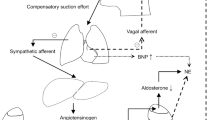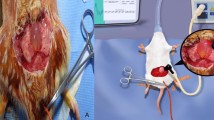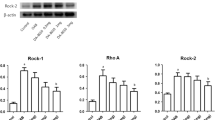Abstract
Objective
The objective of this study was to explore the effect of Alpiniae oxyphyllae Fructus (AOF) on a rat model of chronic intermittent hypoxia (CIH)–induced enuresis. Findings of this study may help identify therapeutic targets in children with nocturnal enuresis (NE).
Methods
Female rats were randomly divided into a control group (saline gavage, 4 weeks of normal air), CIH group (saline gavage, 4 weeks of CIH), and AOF group (AOF gavage, 4 weeks of CIH). The variables measured in this study included water intake, urine output, bladder leak point pressure (BLPP), malondialdehyde (MDA) levels, and superoxide dismutase (SOD) activity. The expression levels of the purinergic P2X3 receptor, muscarinic M3 receptor, and ß3-adrenergic receptor (ß3-AR) in the bladder were also measured. The bladder was subjected to haematoxylin and eosin (HE) and Weigert staining, and histological changes were observed under a light microscope to evaluate the morphological changes in the bladder in each group.
Results
Compared with the control group, urine output was increased, and the BLPP was decreased in the CIH group, but AOF administration decreased urine output and increased BLPP. In addition, the serum MDA level increased and the SOD activity decreased in the CIH group compared with the control group. Administration of AOF decreased the MDA level and increased the SOD activity. Additionally, compared with the control group, HE and Weigert staining in the CIH group showed that the bladder detrusor muscle bundles were disordered and loose, some muscle bundles were broken, the content of collagen fibres in the gap was reduced, and the gap was significantly widened. However, following the administration of AOF, the bladder detrusor muscle bundles were neatly arranged, and the content of collagen fibres in the gap was increased. Furthermore, compared with the control group, the purinergic P2X3 receptor and muscarinic M3 receptor were expressed at higher levels, and ß3-AR was expressed at lower levels in the CIH group, but AOF administration decreased the expression of the purinergic P2X3 receptor and muscarinic M3 receptor and increased the expression of the ß3-AR.
Conclusions
AOF improves enuresis by inhibiting oxidative stress and regulating the expression of the purinergic P2X3 receptor, muscarinic M3 receptor, and ß3 adrenergic receptor.





Similar content being viewed by others
References
Neveus T, von Gontard A, Hoebeke P, Hjalmas K, Bauer S, Bower W, Jorgensen TM, Rittig S, Walle JV, Yeung CK, Djurhuus JC, Kuwertz-Broking E, von Gontard A (2006) The standardization of terminology of lower urinary tract function in children and adolescents: report from the Standardisation Committee of the International Children’s Continence Society Clinical management of nocturnal enuresis. J Urol 176(1):314–324. https://doi.org/10.1016/s0022-5347(06)00305-3
Kuwertz-Broking E, von Gontard A (2018) Clinical management of nocturnal enuresis, vol 33. vol 7. https://doi.org/10.1007/s00467-017-3778-1
Van Herzeele C, Dhondt K, Roels SP, Raes A, Groen LA, Hoebeke P, Walle JV (2015) Neuropsychological functioning related to specific characteristics of nocturnal enuresis. J Pediatr Urol 11(4):208.e201–208.e206. https://doi.org/10.1016/j.jpurol.2015.04.033 %/ Copyright (c) 2015 Journal of pediatric urology company. Published by Elsevier Ltd. All rights reserved
Fleck SC, Hildebrand AA, Pfeiffer E, Metzler M (2012) Catechol metabolites of zeranol and 17beta-estradiol: a comparative in vitro study on the induction of oxidative DNA damage and methylation by catechol-O-methyltransferase. Toxicol Lett 210(1):9–14. https://doi.org/10.1016/j.toxlet.2012.01.010 %/ Copyright A(c) 2012 Elsevier Ireland Ltd. All rights reserved
Munoz A, Smith CP, Boone TB, Somogyi GT (2011) Overactive and underactive bladder dysfunction is reflected by alterations in urothelial ATP and NO release. Neurochem Int 58(3):295–300. https://doi.org/10.1016/j.neuint.2010.12.002 %/ Copyright (c) 2010 Elsevier Ltd. All rights reserved
Heppner TJ, Werner ME, Nausch B, Vial C, Evans RJ, Nelson MT (2009) Nerve-evoked purinergic signalling suppresses action potentials, Ca2+ flashes and contractility evoked by muscarinic receptor activation in mouse urinary bladder smooth muscle. J Physiol 587(Pt 21):5275–5288. https://doi.org/10.1113/jphysiol.2009.178806
Yoshimura N, Miyazato M (2012) Neurophysiology and therapeutic receptor targets for stress urinary incontinence. Int J Urol 19(6):524–537. https://doi.org/10.1111/j.1442-2042.2012.02976.x %/ (c) 2012 The Japanese Urological Association
Jiang YH, Lee CL, Kuo HC (2016) Urothelial dysfunction, suburothelial inflammation and altered sensory protein expression in men with bladder outlet obstruction and various bladder dysfunctions: correlation with urodynamics. J Urol 196(3):831–837. https://doi.org/10.1016/j.juro.2016.02.2958 %/ Copyright (c) 2016 American Urological Association Education and Research, Inc. Published by Elsevier Inc. All rights reserved
Okeke K, Michel-Reher MB, Gravas S, Michel MC (2019) Desensitization of cAMP accumulation via human beta3-adrenoceptors expressed in human embryonic kidney cells by full, partial, and biased agonists. Front Pharmacol 10:596. https://doi.org/10.3389/fphar.2019.00596
Salazar BH, Hoffman KA, Zhang C, Zhang Y, Cruz Y, Boone TB, Munoz A (2019) Modulatory effects of intravesical P2X2/3 purinergic receptor inhibition on lower urinary tract electromyographic properties and voiding function of female rats with moderate or severe spinal cord injury. BJU Int 123(3):538–547. https://doi.org/10.1111/bju.14561 %/ (c) 2018 The Authors BJU International (c) 2018 BJU international Published by John Wiley & Sons Ltd
Birder L, Andersson KE (2013) Urothelial signaling. Physiol Rev 93(2):653–680. https://doi.org/10.1152/physrev.00030.2012
Sun Y, Chai TC (2004) Up-regulation of P2X3 receptor during stretch of bladder urothelial cells from patients with interstitial cystitis. J Urol 171(1):448–452. https://doi.org/10.1097/01.ju.0000099660.46774.3c
Matsumoto Y, Miyazato M, Yokoyama H, Kita M, Hirao Y, Chancellor MB, Yoshimura N (2012) Role of M2 and M3 muscarinic acetylcholine receptor subtypes in activation of bladder afferent pathways in spinal cord injured rats. Urology 79(5):1184.e1115–1184.e1120. https://doi.org/10.1016/j.urology.2012.01.022 %/ Copyright (c) 2012 Elsevier Inc. All rights reserved
Han Y, Wu J, Liu Y, Qi J, Wang C, Yu T, Xia Y, Li H (2019) Therapeutic effect and mechanism of polysaccharide from Alpiniae oxyphyllae fructus on urinary incontinence. Int J BiolMacromol 128:804–813. https://doi.org/10.1016/j.ijbiomac.2019.01.193 %/ Copyright (c) 2019 Elsevier B.V. All rights reserved
Cai XH, Li XC, Jin SW, Liang DS, Wen ZW, Cao HC, Mei HF, Wu Y, Lin ZD, Wang LX (2014) Endoplasmic reticulum stress plays critical role in brain damage after chronic intermittent hypoxia in growing rats. Exp Neurol 257:148–156. https://doi.org/10.1016/j.expneurol.2014.04.029 %/ Copyright (c) 2014. Published by Elsevier Inc
Austin PF, Bauer SB, Bower W, Chase J, Franco I, Hoebeke P, Rittig S, Walle JV, von Gontard A, Wright A, Yang SS, Neveus T (2016) The standardization of terminology of lower urinary tract function in children and adolescents: update report from the standardization committee of the International Children’s Continence Society. NeurourolUrodyn 35(4):471–481. https://doi.org/10.1002/nau.22751 %/ (c) 2015 Wiley Periodicals, Inc
Kosilov KV, Geltser BI, Loparev SA, Kuzina IG, Shakirova OV, Zhuravskaya NS, Lobodenko A (2018) The optimal duration of alarm therapy use in children with primary monosymptomatic nocturnal enuresis. J PediatrUrol 14(5):447.e441–447.e446. https://doi.org/10.1016/j.jpurol.2018.03.021 %/ Copyright (c) 2018 Journal of Pediatric Urology Company. Published by Elsevier Ltd. All rights reserved
Thiedke CC (2003) Nocturnal enuresis. Am Fam Physician 67(7):1499–1506
Su MS, Zhang HL, Cai XH, Lin Y, Liu PN, Zhang YB, Hu WZ, Li CC, Xiao YF (2016) Obesity in children with different risk factors for obstructive sleep apnea: a community-based study. Eur J Pediatr 175(2):211–220. https://doi.org/10.1007/s00431-015-2613-6
Obara K, Kobayashi Y, Chino D, Tanaka Y (2017) Effects of distigmine on electrical field stimulation-induced contraction of mouse urinary bladder smooth muscles. Pharmacology 99(3-4):106–113. https://doi.org/10.1159/000452222 %/ (c) 2016 S. Karger AG, Basel
Wang WY, Zeng YM, Chen XY, Zhang YX (2013) Effect of Telmisartan on local cardiovascular oxidative stress in mouse under chronic intermittent hypoxia condition. Sleep Breath 17(1):181–187. https://doi.org/10.1007/s11325-012-0669-3
Li W, Yang S, Yu FY, Zhao Y, Sun ZM, An JR, Ji E (2018) Hydrogen ameliorates chronic intermittent hypoxia-induced neurocognitive impairment via inhibiting oxidative stress. Brain Res Bull 143:225–233. https://doi.org/10.1016/j.brainresbull.2018.09.012 %/ Copyright (c) 2018 Elsevier Inc. All rights reserved
Hanna-Mitchell AT, Ruiz GW, Daneshgari F, Liu G, Apodaca G, Birder LA (2013) Impact of diabetes mellitus on bladder uroepithelial cells. Am J PhysiolRegulIntegr Comp Physiol 304(2):R84–R93. https://doi.org/10.1152/ajpregu.00129.2012
Ferguson AC, Sutton BW, Boone TB, Ford AP, Munoz A (2015) Inhibition of urothelial P2X3 receptors prevents desensitization of purinergic detrusor contractions in the rat bladder. BJU Int 116(2):293–301. https://doi.org/10.1111/bju.13003 %/ (c) 2014 The Authors BJU International (c) 2014 BJU International Published by John Wiley & Sons Ltd
Chua WC, Liu L, Mansfield KJ, Vaux KJ, Moore KH, Millard RJ, Burcher E (2007) Age-related changes of P2X(1) receptor mRNA in the bladder detrusor from men with and without bladder outlet obstruction. Exp Gerontol 42(7):686–692. https://doi.org/10.1016/j.exger.2007.02.003
Khastgir J (2019) Antimuscarinic drug therapy for overactive bladder syndrome in the elderly - are the concerns justified? Expert OpinPharmacother 20(7):813–820. https://doi.org/10.1080/14656566.2019.1574749
Liu Q, Luo D, Yang T, Liao B, Li H, Wang KJ (2017) Protective effects of Antimuscarinics on the bladder remodeling after bladder outlet obstruction. Cell Physiol Biochem 44(3):907–919. https://doi.org/10.1159/000485358 %/ (c) 2017 The author(s). Published by S. Karger AG, Basel
Chen SF, Lee CL, Kuo HC (2019) Changes in sensory proteins in the bladder urothelium of patients with chronic kidney disease and end-stage renal disease. Low Urin Tract Symptoms 11(2):O202–O208. https://doi.org/10.1111/luts.12240 %/ (c) 2018 John Wiley & Sons Australia, Ltd
Propping S, Lorenz K, Michel MC, Wirth MP, Ravens U (2016) Beta-adrenoceptor-mediated relaxation of urinary bladder muscle in beta2-adrenoceptor knockout mice. Front Pharmacol 7:118. https://doi.org/10.3389/fphar.2016.00118
Funding
This study was funded by the Natural Science Foundation of China (grant number 81870075) and the Zhejiang Province Natural Science Funding Project (grant numberLY17H010003).
Author information
Authors and Affiliations
Contributions
S-MS designed the study and edited the manuscript. XL performed the experiments, analysed data, and wrote the manuscript. G-SG, HN and R-XK performed the experiments. C-XH supervised the study and assisted with the compound test simulation cabin. L-CC supervised the study and edited the manuscript. All authors approved the final version of the manuscript.
Corresponding author
Ethics declarations
Conflict of interest
The authors declare that they have no conflict of interest.
Ethical approval
All applicable international, national, and/or institutional guidelines for the care and use of animals were followed. Ethical approval was obtained from the Laboratory Animal Ethics Committee of Wenzhou Medical University (ID Number: wydw2017-0087).
Additional information
Comments
Nocturnal enuresis is a significant problem with relatively few effective remedies. In this study, the effects of a traditional Chinese medicine on bladder function were shown to be associated with helpful changes in the bladders of female rats. Perhaps not ready for Prime Time but perhaps sometime?
Ian Wilcox
NSW, Australia
Publisher’s note
Springer Nature remains neutral with regard to jurisdictional claims in published maps and institutional affiliations.
Rights and permissions
About this article
Cite this article
Su, MS., Xu, L., Gu, SG. et al. Therapeutic effects and modulatory mechanism of Alpiniae oxyphyllae Fructus in chronic intermittent hypoxia induced enuresis in rats. Sleep Breath 24, 329–337 (2020). https://doi.org/10.1007/s11325-019-01983-4
Received:
Revised:
Accepted:
Published:
Issue Date:
DOI: https://doi.org/10.1007/s11325-019-01983-4




